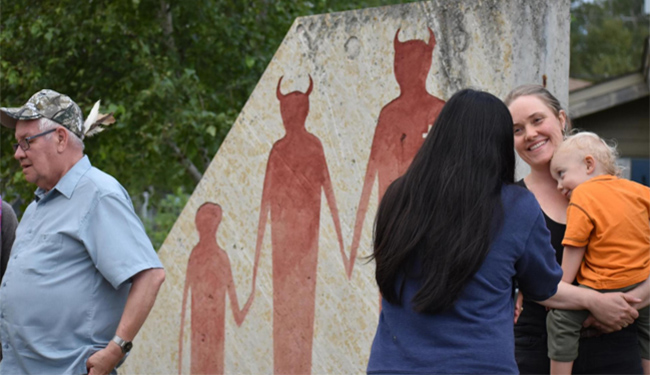Nbwaach’ding (visiting) and Anishinaabe knowledge on Manitoulin Island

By Nicole Latulippe
The young people wanted to know more. This, explained respected Elder Lewis Debassige of M’Chigeeng First Nation, initiated the cultural reawakening of the 1970s on Manitoulin Island. Cultural arts, language, and Anishinaabewin education grew, as did a number of specialized organizations, including what has become the Ojibwe Cultural Foundation (OCF). Today, Curator Anong Beam shared, the OCF acts as a gathering place, a source of information, and resource centre for practitioners of, and those desiring to know more about, Anishinaabe art, history, archaeology, language, storytelling, and spirituality. An Indigenous space, it is also a community-building space.
This summer, the OCF hosted a group of graduate students, University educators and administrators, traditional knowledge holders, researchers, artists, and young people for the week-long Manitoulin Island Summer Historical Institute. Known as MISHI, it is the result of a good working relationship between the OCF and a research cluster at York University called the History of Indigenous People’s Network.
Building community, sharing knowledge, and learning with each other, the week’s activities encompassed what Lewis called Nbwaach’ding, roughly translated as visiting together. We learned this way, through conversation, storytelling, and visiting important sites. Lewis, Anong, and other accomplished Anishinaabe scholars, artists, and knowledge keepers including Alan Corbiere, Steven George, Marion and Deborah McGregor, Michael Belmore, and Nico Williams shared stories with the group: Nanabozho’s creative exploits around Lake Mindemoya, research ethics at Dreamer’s Rock, cultural hybridity at Holy Cross Roman Catholic Church at Wikwemikong, and the renewal of nation-to-nation relations at Manitowaning. It struck me that our education was also active and tactile. We practiced beadwork, were gifted and braided sweetgrass, waded into the Kagawong River, and felt the same winds, rain, and rocks as the Odawa ancestors at an important archeological site. Transformation, reciprocity, replenishment, and presence were not just abstract concepts. We felt our way into these teachings with all of our senses.
Speaking with Lewis at the end of the week, I came right out and asked to what value he ascribes programs like MISHI. The TRC calls for non-Indigenous governments and institutions to do their work for reconciliation in education, culture, and in other areas, yet here is a program where Indigenous people it seems were doing the bulk of education work. He pointed at the young kids playing out front at the OCF, children and grandchildren of some participants who had taken part in the week’s activities. This, he is said, is building a team. Building family. There is an absolute need for everybody to have access to Indigenous knowledge, he continued, essential as it is to the survival of the earth and all beings.
Thanks to the young people of multiple generations and to their enduring vision we got to learn something of the curiosity, engagement, and bridging work necessary to build community. By facilitating relationships and sharing wisdom, the MISHI organizers, Elders, and teachers modeled what it is to embody Anishinaabe knowledge – that is, to enact one’s responsibilities towards a future that is fit for the survival of all beings.


